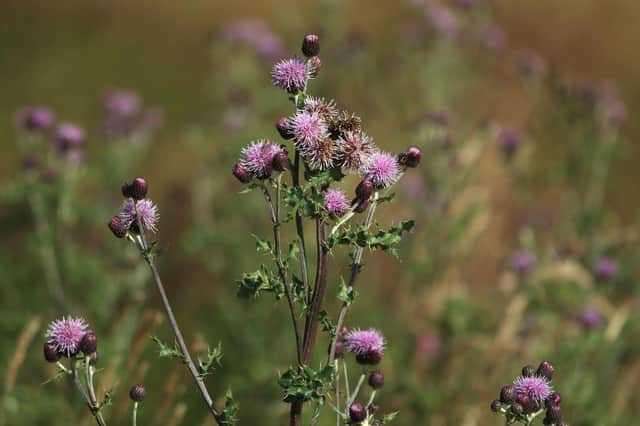Scottish and Jewish connections: How I discovered the mamaloshen of my childhood during 'A Daunder Through Thistles' – Joe Goldblatt


My grandmother of blessed memory often read me stories, in her thick eastern European accent, in what to Jewish people throughout the world is known as Yiddish. As Jews migrated to Scotland from Lithuania, a new dialect was created, which the late English literature scholar and chronicler of Jewish culture in Scotland, Professor David Daiches, referred to as “Scots Yiddish”. As an example of the seamless blending of these two languages, he referred to a phrase he had heard from a Jewish boyhood friend: “Vot time’s yer barmitzvie, laddie?” (What time is your bar mitzvah, boy?)
But the connections may run deeper. When Christina Stewart, Susi Briggs, Grace Stewart-Skinner and Alpin Stewart recently took the stage at the Scottish Storytelling Centre, the fine hairs on the back of my neck rose as they began to speak fluidly and seamlessly in Gaelic, Scots and English. I immediately felt that I was once again listening to the mamaloshen of my childhood as their expert pronunciation sounded so similar to the musical language of my youth.
Advertisement
Hide AdAdvertisement
Hide AdTheir brisk and deeply moving one-hour musical drama, entitled A Daunder Through Thistles, is in fact a wee wander through a lifetime of human experience from birth, to childhood, to adolescence, marriage, and finally death. The stories told by the performers are deeply moving and resonate with all age groups as their messages are universal and encompass lives that are well-lived with compassion, love, and hope.
Christina begins by reminding the audience that “life is a journey”. Thistles are the symbols for this journey as they are both colourful and hardy. Her brilliant smile and bright eyes radiated intrigue as well as mystery as she and her fellow players began to spin tall tales from Scottish folklore. The first tale involved the land of the fairies and, through the use of music and spoken verse, one could actually almost see the fairies flying throughout the theatre.
Christina painted beautiful word pictures as she described the yellow fairy flag that is the ancient banner of the Clan MacLeod. It was symbolic of their success and is displayed today at their seat at Dunvegan Castle. Due to Christina’s highly visual description of the fairies and their flag, you could almost hear it rustling in the wind. And as her eyes rose to the heavens to admire their fluttering yellow banner, so did ours.
Susi Briggs is a master storyteller whose melodic voice, effective use of a pause, magical wink of her eye, and occasional dramatic gasp, drew every audience member deeply into her true story of the love affair of Susi and Brian. The story involves a romance that took 24 years to reach full blossom and, with every line the storyteller recited, we fell more deeply in love with the characters and our hearts were soon overflowing with empathy and finally delight.
Grace Stewart-Skinner is an accomplished musician whose command of the traditional Scottish harp, the Clarsach, mesmerised the audience with her gentle touch of each string. In addition to performing several traditional Scottish melodies, Grace also emotionally and expertly joined the storytellers in spoken verse and song.
The fourth member of this extraordinary ensemble is Alpin Stewart whose spoken Gaelic provided a source of the gravitas and great depth of the spirit of the Highlands and Isles that is needed to ground this performance in traditional Scottish folkloric experience. His strong voice caressed each of the Gaelic words in a way that made one recall sitting in a croft in the Highlands and listening to a favourite uncle tell tall tales by a glowing peat-fired hearth.
The programme concluded with the best rendition I have ever witnessed of poet Hamish Henderson’s The Flyting o’ Life and Daith. In this poem, the characters of Death and Life debate one another until the latter finally triumphs. Performed by Susi and Christina, the audience quickly engaged in this lively match of two strong wills and soon we were relieved when, as we should be, life emerged triumphant.
The final melody spontaneously encouraged the audience to sing along as our voices blended with the performers in singing the final words: “Keep you in peace until we meet again.” The performers, lined up at the front of the beautifully decorated stage, held the final note along with the audience as if to encourage one another to continue forever this never-ending story of fairies, life and death, and finally hope.
Advertisement
Hide AdAdvertisement
Hide AdSome scholars actually believe that Gaelic and the Jewish ancient language of Hebrew have many similarities in their pronunciation and may even have a shared origin. Perhaps that is why when I heard the musical language of Gaelic, Scots, and English so expertly performed, I remembered and cherished once again the tender mamaloshen stories of my own grandmother.
Thanks to the rare talents of these four storytellers, a Jewish man who emigrated from a boyhood in Texas to an adulthood in Scotland once again heard his grandmother’s beloved voice. Thanks also to these expert guides, my daunder through the thistles was both colourful, hard, and filled with hope for a better world. Hamish Henderson wrote “Quo life, the warld is mine” and these remarkable performers wove a beautiful tapestry of elegant tales that shall be remembered and treasured for as long as we believe in fairies, romance, and our mysterious journey through life itself.
Joe Goldblatt is emeritus professor of planned events at Queen Margaret University, Edinburgh. He is a member of the council for the Saltire Society of Scotland. To learn more about his views visit www.joegoldblatt.scot
Comments
Want to join the conversation? Please or to comment on this article.